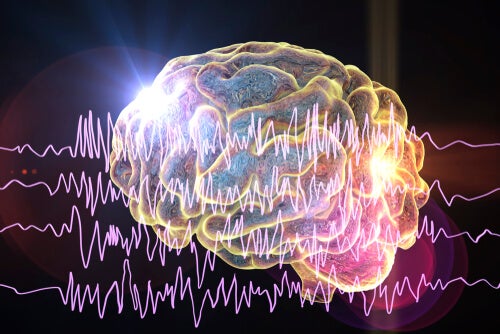What Are Epilepsy Auras?

Epilepsy is a neurological disorder that affects the central nervous system. Abnormal brain activity triggers seizures, unusual behavior or sensations, and, sometimes, loss of consciousness. Together, these symptoms make up what doctors call epileptic seizures. The sensations that a person experiences just before a seizure, while still conscious, are called epilepsy auras.
Epilepsy auras can involve a strange smell or taste, or feelings of fear, discomfort, or even well-being. Epilepsy auras usually happen before the individual loses consciousness. In that sense, the auras are positive because they give the person a chance to protect themselves before the seizure starts.

What are epilepsy auras?
At the cerebral level, epilepsy auras are the result of an altered activation in the cerebral cortex due to neurons firing in an abnormal way. They happen in a specific part of one hemisphere for a short period of time (from a few seconds to several minutes). In other words, abnormal activation occurs in a concrete functional area of the brain. The characteristics of the aura will depend on which area is affected.
Because the person is conscious during the aura, with “abnormal” behaviors in only specific parts of the brain (compared to a full-on seizure), they’re considered partial seizures or focal aware seizures (FAS). For some people, focal aware seizures can develop into another type of seizure and result in loss of consciousness.
Types of auras
While there’s still some ambiguity regarding the classification of the different types of auras, experts tend to group them according to their symptoms. That’s because the symptoms have to do with the particular area of the brain where the seizure originates.
Autonomic auras
When abnormal brain activation occurs in the autonomic system, symptoms include vomiting, racing heartbeat, goosebumps, pale skin, etc.
The most common symptoms in this group are epigastric. These kinds of symptoms are often related to epilepsy in the temporal lobe. Patients might feel nauseous, like their stomach is empty, or experience abdominal pressure.
Experiential auras
Experiential symptoms are related to alterations in the limbic system and the temporal cortex. Consequently, these can affect memory, emotions, and cognition. They can also cause perceptive illusions or sensory hallucinations. These are also called psychic auras. It’s sometimes difficult to differentiate if these symptoms have a psychological or sensory origin.
Amnesiac alterations also fall into this category, which is when the patient distorts memories or experiences deja vu, depersonalization, or derealization. In the case of emotional auras (associated with the amygdala in medial frontal lobe epilepsy), people describe feelings of sadness, joy, pleasure, or irritability. They might also feel anxious or scared that they’re going to have a heart attack.
Sensory auras
Auras that are exclusively sensory affect one of the senses. For example, auras associated with occipital or temporal seizures might involve eye floaters, problems seeing movements, or even blindness.
When the alterations affect more complex visual areas, they can cause visual hallucinations or tunnel vision. Auditory problems are also possible, such as whistling in the ears, buzzing, hearing other noises, or problems with smell and taste.
Parietal or frontal epilepsy can cause somatosensorial auras, which involve numbness, paresthesia, cold or hot sensation, pain, etc.
Other kinds of auras
These classifications of epilepsy auras still trigger debate and controversy, since auras tend to be defined as the sensations that patients experience with no clear visible signs. Nevertheless, patients also report motor auras, cephalic auras, erotic auras, and sexual auras.
Motor auras can involve muscle contractions, phonatory disorders, masticatory movements, etc. However, these symptoms can come from other alterations, such as psychic auras, autonomic auras, or somatosensorial auras.
Some experts classify cephalic auras as somatosensory auras since the associated symptoms are dizziness, heaviness, or head pressure.
Lastly, sexual auras consist of sensations in the genitals, erotic feelings, or even the so-called “orgasmic epilepsy”, which ends in a sometimes painful orgasm. Some experts classify sexual auras in their own category, while others consider them autonomic auras.

A differential diagnosis for epilepsy auras
It’s important to note that epilepsy auras are often confused with other conditions due to the variety of potential symptoms. Doctors most frequently attribute the symptoms to cardiovascular disorders or panic attacks. However, they might also be a sign of otorhinolaryngological disorders, serious mental disorders, or drug use.
Consequently, it’s important to get a proper diagnosis and work with experts who have the proper resources at their disposal. They have to identify all the symptoms and the associated alterations, as well as the type of epilepsy they’re dealing with.
All cited sources were thoroughly reviewed by our team to ensure their quality, reliability, currency, and validity. The bibliography of this article was considered reliable and of academic or scientific accuracy.
- Fernández-Torre, J.L. (2002). Auras epilépticas: clasificación, fisiopatología, utilidad práctica, diagnóstico diferencial y controversias. Neurología, 34(10), 977-983.
This text is provided for informational purposes only and does not replace consultation with a professional. If in doubt, consult your specialist.








